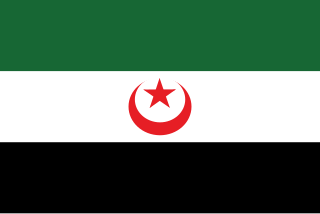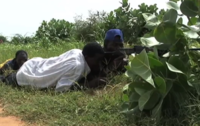
Azawad, or Azawagh, was a short-lived unrecognised state lasting between 2012 and 2013. Azawagh (Azawaɣ) is the generic Tuareg Berber name for all Tuareg Berber areas, especially the northern half of Mali and northern and western Niger. The Azawadi declaration of independence was declared unilaterally by the National Movement for the Liberation of Azawad (MNLA) in 2012, after a Tuareg rebellion drove the Malian Armed Forces from the region.

Douentza is a town and urban commune in the Mopti Region of central Mali. The town lies 145 km east-northeast of Mopti on the RN16, a paved road that links Mopti and Gao. It is the administrative center of the Douentza Cercle.

The 2012 Tuareg rebellion was the early phase of the Mali War; from January to April 2012, a war was waged against the Malian government by rebels with the goal of attaining independence for the northern region of Mali, known as Azawad. It was led by the National Movement for the Liberation of Azawad (MNLA) and was part of a series of insurgencies by traditionally nomadic Tuaregs which date back at least to 1916. The MNLA was formed by former insurgents and a significant number of heavily armed Tuaregs who fought in the Libyan Civil War.

The National Movement for the Liberation of Azawad or the Azawad National Liberation Movement, formerly the National Movement of Azawad, is a militant organization based in northern Mali.
The Movement for Oneness and Jihad in West Africa or the Movement for Unity and Jihad in West Africa, was a militant Islamist organisation that broke off from Al-Qaeda in the Islamic Maghreb with the intended goal of spreading jihad across a larger section of West Africa, as well as demanding the expulsion of all French interests that operate in West Africa, which they regard as "colonialist occupiers".

Ansar Dine (Arabic: أنصار الدين ʾAnṣār ad-Dīn, also transliterated Ançar Deen; meaning "helpers of the religion" also known as Ansar al-Din was a Salafi jihadist group led by Iyad Ag Ghaly. Ansar Dine sought to impose absolute sharia across Mali. The group took over the city of Timbuktu in 2012, which prompted the French-led intervention, Operation Serval.

The 2012 Malian coup d'état began on 21 March that year, when mutinying Malian soldiers, displeased with the management of the Tuareg rebellion, attacked several locations in the capital Bamako, including the presidential palace, state television, and military barracks. The soldiers, who said they had formed the National Committee for the Restoration of Democracy and State, declared the following day that they had overthrown the government of Amadou Toumani Touré, forcing him into hiding. The coup was followed by "unanimous" international condemnation, harsh sanctions by Mali's neighbors, and the swift loss of northern Mali to Tuareg forces, leading Reuters to describe the coup as "a spectacular own-goal". On 6 April, the junta agreed with Economic Community of West African States (ECOWAS) negotiators that they would step down from power in return for the end of sanctions, giving power to a transitional government led by parliament speaker Dioncounda Traoré. In the following days, both Touré and coup leader Amadou Sanogo formally resigned; however, as of 16 May, the junta was still "widely thought to have maintained overall control". On 3 December 2013, a mass grave was discovered in Diago holding the remains of 21 soldiers that went missing the year before, loyal to the ousted president.
Iyad Ag Ghaly, also known as Abū al-Faḍl, is a Tuareg Islamist militant from Mali's Kidal Region. He has been active in Tuareg rebellions against the Malian government since the 1980s – particularly in the early 1990s. In 1988, he founded the Popular Movement for the Liberation of Azawad. In the latest episode of the Tuareg upheavals in 2012, he featured as the founder and leader of the Islamist militant group Ansar Dine.

The Battle of Gao was fought between the National Movement for the Liberation of Azawad (MNLA) and the Islamist Movement for Oneness and Jihad in West Africa (MOJWA), along with its ally Ansar Dine, in Gao between 26–28 June 2012. By the 28 June, Gao, Timbuktu and Kidal, the three biggest cities in the disputed secessionist region of Azawad within what is recognised as Malian territory, were under the control of Ansar Dine and its Islamist allies.

The Mali War is an ongoing conflict that started in January 2012 between the northern and southern parts of Mali in Africa. On 16 January 2012, several insurgent groups began fighting a campaign against the Malian government for independence or greater autonomy for northern Mali, which they called Azawad. The National Movement for the Liberation of Azawad (MNLA), an organization fighting to make this area of Mali an independent homeland for the Tuareg people, had taken control of the region by April 2012.

The Second Battle of Ménaka was the last battle fought by the state of Azawad, as they were defeated by an Islamist coalition.
The Battle of Aguelhok occurred when rebels from the National Movement for the Liberation of Azawad (MNLA) and Islamists groups Ansar Dine and Al-Qaeda in the Islamic Maghreb attacked a Malian army garrison base in the town of Aguelhok, Kidal Region of Northern Mali on 17 January 2012, as part of the larger Tuareg rebellion to seize all government bases in the region.
The Amachach military base in Tessalit was defended by roughly 800 Malian soldiers commanded by Colonel Kassim Goita, with 1,500 refugees being mostly Tuareg women and children. The International Committee of the Red Cross was sent to help evacuate civilians and military families, but despite the approval of the MNLA, Malian authorities delayed the operation and it was never executed as a humanitarian source. Other Malian military forces in the region of Tessalit were led by Colonels' Didier Dacko, Ould Meydou, and the well respected Tuareg commander El Hadji Ag Gamou.

The following is a timeline of major events during the Northern Mali conflict.

The Arab Movement of Azawad is an Arab military organization active in Azawad/northern Mali. Initially known as the National Liberation Front of Azawad, it was formed in early 2012, during the 2012 Tuareg rebellion. The MAA claims to be a secular, non-terrorist organization, whose main objective is to defend the interests of all the Arab peoples of northern Mali.
The Azawad conflict has been a conflict in Northern Mali between the MNLA, a Tuareg nationalist group, and a coalition of Islamist groups. The conflict began when Northern Mali declared itself independent from the government, creating the unrecognized state of Azawad. The Islamists and MNLA formed an alliance in combatting the Malian government. An internal conflict sprung up over the imposing of sharia law in the new state and the MNLA distancing itself from the coalition to a democratic state. Islamists gained popularity amongst anti-Tuareg tribes which helped them overthrow MNLA authority in Gao. Both sides clashed repeatedly leading to the Battle of Gao, where the MNLA were driven from the North's two main cities, Gao and Timbuktu. The MNLA soon lost all of its strongholds in the North in a matter of months. They went into hiding secretly gaining support and strength. The beginning of 2013 led to the start of the French intervention in Mali that ousted the Islamists from the North's cities and brought back Malian authority. The MNLA supported the French and Chadian forces in military operations against Islamists' sanctuaries in the mountains. The MNLA recaptured several important towns in the Kidal Region but refused to disarm or hand them over to the Malian government. A series of Islamist-sponsored terror attacks plagued MNLA forces for siding with the French. Checkpoints and bases were targeted with suicide bombings that targeted MNLA members. A peace deal was reached with the Malian army in June that let the army transverse freely in MNLA-occupied zones that were under Malian jurisdiction. Ethnic violence sprung over the murder of a Tuareg Government officer's family. The MNLA responded by harassing and murdering Fulani civilians, who constitute a majority of Islamist rebels. The Islamists stepped up their attacks in one such instance massacring 30 Tuareg merchants. The MNLA has since been battling Islamists.
The Katibat Macina, also known as the Macina Liberation Movement or Macina Liberation Front, is a militant Islamist group that operates in Mali. It is an affiliate of Ansar Dine.
The Ambush of Tin-Hama took place during the Tuareg rebellion of 2012, on March 25, 2012, when a convoy of the Ganda Izo militia was ambushed by the MNLA.
On 15 March 2012, MNLA rebels attacked a Ganda Izo militia base in Soudere, 35 kilometers east of Tessit. According to information provided to the Malian press, the fight lasted from 8am to 5pm. Amadou Diallo, the leader of the Ganda Izo militia, claims that the attack was carried out by the Tuareg rebel Akli Iknane of the Imghad tribe. He and his men were deserters from the Malian National Guard who had been sent to fight MNLA.
El Hadj Ag Gamou, born December 31, 1964, in Tidermène, Mali, is an Imghad Tuareg Malian division general. Gamou is currently the governor of Kidal Region since November 22, 2023, and has also been the head of his faction of Imghad Tuareg Self-Defense Group and Allies since the group's foundation. Prior to his governorship, Gamou served in the Malian army, commanding Malian troops against Ansar Dine and the National Movement for the Liberation of Azawad (MNLA) in the early stages of the Mali War.










